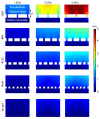Stretchable Capacitive Pressure Sensing Sleeve Deployable onto Catheter Balloons towards Continuous Intra-Abdominal Pressure Monitoring
- PMID: 34069108
- PMCID: PMC8157154
- DOI: 10.3390/bios11050156
Stretchable Capacitive Pressure Sensing Sleeve Deployable onto Catheter Balloons towards Continuous Intra-Abdominal Pressure Monitoring
Abstract
Intra-abdominal pressure (IAP) is closely correlated with intra-abdominal hypertension (IAH) and abdominal compartment syndrome (ACS) diagnoses, indicating the need for continuous monitoring. Early intervention for IAH and ACS has been proven to reduce the rate of morbidity. However, the current IAP monitoring method is a tedious process with a long calibration time for a single time point measurement. Thus, there is the need for an efficient and continuous way of measuring IAP. Herein, a stretchable capacitive pressure sensor with controlled microstructures embedded into a cylindrical elastomeric mold, fabricated as a pressure sensing sleeve, is presented. The sensing sleeve can be readily deployed onto intrabody catheter balloons for pressure measurement at the site. The thin and highly conformable nature of the pressure sensing sleeve captures the pressure change without hindering the functionality of the foley catheter balloon.
Keywords: IAP monitoring; biomedical monitoring; pressure sensor; sensing sleeve; soft sensors.
Conflict of interest statement
The authors declare no conflict of interest.
Figures









Similar articles
-
Non-invasive and continuous intra-abdominal pressure assessment using MC sensors.Sci Rep. 2025 Mar 28;15(1):10775. doi: 10.1038/s41598-025-95512-x. Sci Rep. 2025. PMID: 40155446 Free PMC article.
-
The evaluation of the effect of body positioning on intra-abdominal pressure measurement and the effect of intra-abdominal pressure at different body positioning on organ function and prognosis in critically ill patients.J Crit Care. 2012 Apr;27(2):222.e1-6. doi: 10.1016/j.jcrc.2011.08.010. Epub 2011 Oct 26. J Crit Care. 2012. PMID: 22033056
-
Evaluation of the TraumaGuard Balloon-in-Balloon Catheter Design for Intra-Abdominal Pressure Monitoring: Insights from Pig and Human Cadaver Studies.Sensors (Basel). 2023 Oct 29;23(21):8806. doi: 10.3390/s23218806. Sensors (Basel). 2023. PMID: 37960507 Free PMC article.
-
Intra-abdominal hypertension and abdominal compartment syndrome in pancreatitis, paediatrics, and trauma.Anaesthesiol Intensive Ther. 2015;47(3):219-27. doi: 10.5603/AIT.a2015.0027. Epub 2015 May 14. Anaesthesiol Intensive Ther. 2015. PMID: 25973660 Review.
-
A user's guide to intra-abdominal pressure measurement.Anaesthesiol Intensive Ther. 2015;47(3):241-51. doi: 10.5603/AIT.a2015.0025. Epub 2015 May 14. Anaesthesiol Intensive Ther. 2015. PMID: 25973661 Review.
Cited by
-
Validation of continuous intraabdominal pressure measurement: feasibility and accuracy assessment using a capsular device in in-vivo studies.World J Emerg Surg. 2024 Jun 26;19(1):25. doi: 10.1186/s13017-024-00553-8. World J Emerg Surg. 2024. PMID: 38926694 Free PMC article.
-
Design, Fabrication, and Dynamic Environmental Test of a Piezoresistive Pressure Sensor.Micromachines (Basel). 2022 Jul 19;13(7):1142. doi: 10.3390/mi13071142. Micromachines (Basel). 2022. PMID: 35888959 Free PMC article.
-
Progress in Probe-Based Sensing Techniques for In Vivo Diagnosis.Biosensors (Basel). 2022 Oct 31;12(11):943. doi: 10.3390/bios12110943. Biosensors (Basel). 2022. PMID: 36354452 Free PMC article. Review.
-
Frontiers of Wearable Biosensors for Human Health Monitoring.Biosensors (Basel). 2023 Oct 31;13(11):964. doi: 10.3390/bios13110964. Biosensors (Basel). 2023. PMID: 37998139 Free PMC article.
-
A Review of Recent Advancements in Sensor-Integrated Medical Tools.Adv Sci (Weinh). 2024 May;11(20):e2307427. doi: 10.1002/advs.202307427. Epub 2024 Mar 9. Adv Sci (Weinh). 2024. PMID: 38460177 Free PMC article. Review.
References
-
- Malbrain M.L.N.G., Cheatham M.L., Kirkpatrick A., Sugrue M., Parr M., De Waele J., Balogh Z., Leppäniemi A., Olvera C., Ivatury R., et al. Results from the International Conference of Experts on Intra-abdominal Hypertension and Abdominal Compartment Syndrome. I. Definitions. Intensiv. Care Med. 2006;32:1722–1732. doi: 10.1007/s00134-006-0349-5. - DOI - PubMed
MeSH terms
Grants and funding
LinkOut - more resources
Full Text Sources
Research Materials

